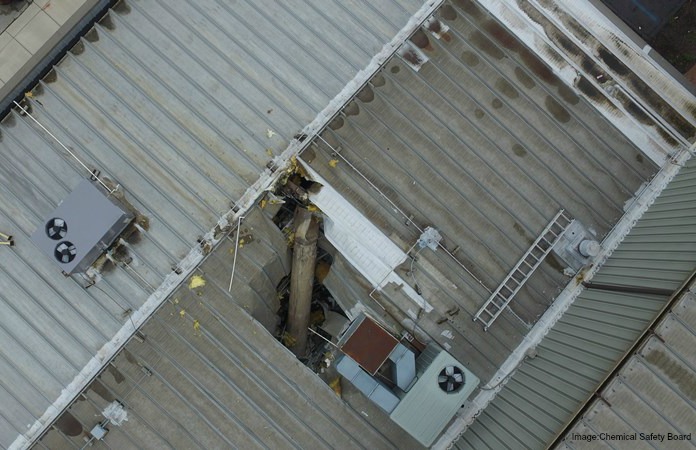The boiler tank that exploded killing four people at two St. Louis companies on April 3 had a history of leaks, according to a report by the U.S. Chemical Safety Board (CSB) which is investigating the incident.
The explosion, which released energy equivalent to 350 pounds of TNT, launched the 3,000-pound tank through Loy-Lange’s roof and sent it hurtling through the air the distance of a city block before it crashed through the roof of Faultless Healthcare Linen. (Loy-Lange is located at 222 Russell Boulevard; Faultless Healthcare Linen is one block away at the corner of Russell Boulevard and South Broadway.)
Loy-Lange employee Kenneth Trentham, 59, died at the scene. Tonya Gonzalez-Suarez, 43, her husband 46-year-old Christopher Watkins and their friend Clifford Lee, 53, were preparing to start their first day of work at Faultless. Watkins and Gonzalez-Suarez were killed instantly when the tank crashed through the roof. Lee died from his injuries three days after the explosion. Another Loy-Lange employee, whose name was not released, was hospitalized with injuries. The Sons and Daughters of Soulard, a charitable group, has set up a GoFundMe page to help the victims and their families.
The vertical condensate storage tank, or semi-closed receiver, that provided condensate or hot water to the steam generated boiler system measured 30 inches in diameter and 20 to 25 feet in length. At the time of the explosion, the tank contained about 510 gallons of 330˚F water. When the tank failed, the water rushed out converting to steam instantly producing a force so strong that the tank ripped from its fittings and launched on its deadly trajectory at a speed of 120 mph. It flew about 425 feet into the air and about 515 feet from its starting point, remaining airborne for over 10 seconds, the CSB has determined.
Weeks ago, the CSB determined that the explosion was caused by a “catastrophic failure” at the bottom of the tank. The agency has since learned that the tank had a “history of leaks.”
In 2012, the tank was leaking at its base and was repaired. But the entire bottom of the tank, which is 30 inches in diameter, was not replaced. Instead, a 24-inch circle in the center of the bottom was replaced.
CSB investigators say the failure on April 3, occurred in the 6-inch band of the base that was not replaced during the 2012 repair. The metal in the band was half as thick as it should have been. “While the thickness of the metal should have been a quarter of an inch (0.25”) thick, this specific area had been worn down to eight-hundredths of an inch (0.08”),” the CSB report states.
On Friday, March 31, the employees noticed the tank was leaking from two different areas of the ring, They shut down the system and called a repair service provider who was scheduled to come on April 3. It is not clear why, on the morning of April 3, the system was started up prior to the arrival of the repair technician. The explosion occurred toward the end of the 90-minute start-up process.
Our lead attorneys for these cases, Fred Pritzker and Eric Hageman, can be reached by calling 1 (888) 377-8900 (toll-free) or with this online free consultation form.